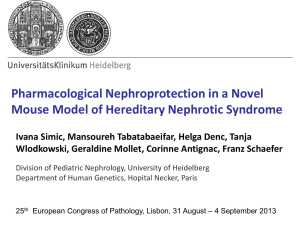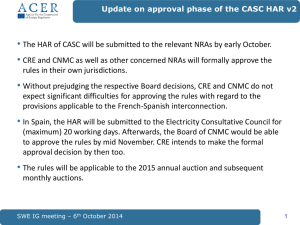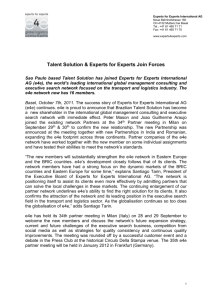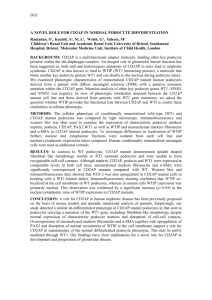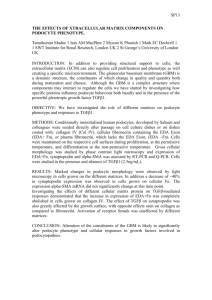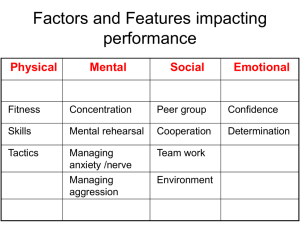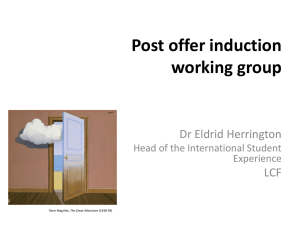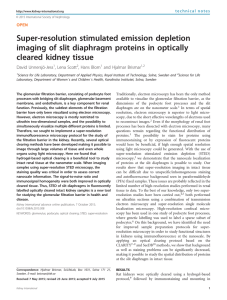Podocyte Loss and Glomerulosclerosis in Inducible Mouse Model
advertisement
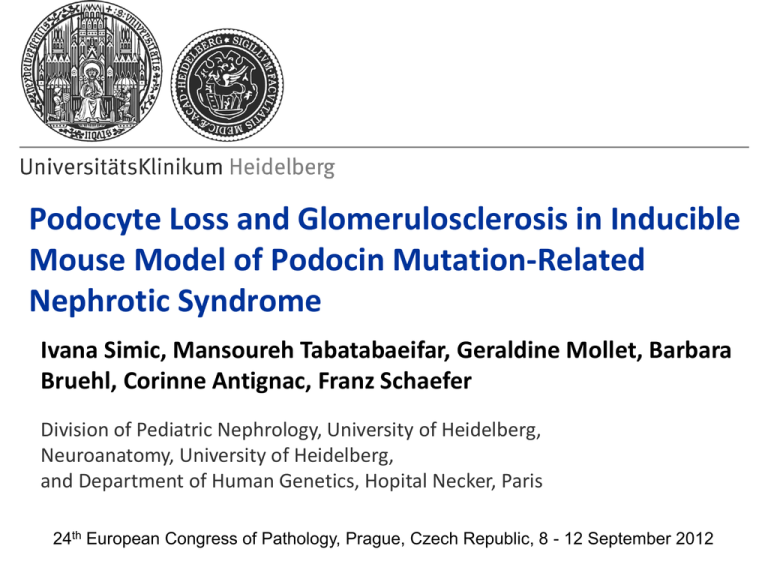
Podocyte Loss and Glomerulosclerosis in Inducible Mouse Model of Podocin Mutation-Related Nephrotic Syndrome Ivana Simic, Mansoureh Tabatabaeifar, Geraldine Mollet, Barbara Bruehl, Corinne Antignac, Franz Schaefer Division of Pediatric Nephrology, University of Heidelberg, Neuroanatomy, University of Heidelberg, and Department of Human Genetics, Hopital Necker, Paris 24th European Congress of Pathology, Prague, Czech Republic, 8 - 12 September 2012 The NPHS2 Gene and Hereditary Nephrotic Syndrome • Mutations in the NPHS2 gene, encoding podocin, cause autosomal recessive steroid-resistant nephrotic syndrome • R138Q, the most common podocin mutation in Europeans, causes early disease onset and rapid progression to end-stage renal disease N-term C-term R138Q The NPHS2 Gene and Hereditary Nephrotic Syndrome • The R138Q mutation causes retention of podocin in the ER, leading to impaired SD formation and foot process effacement • Knock-in mice carrying the R140Q mutation, the mouse analogue of human R138Q, show developmental arrest of podocytes and lethal renal failure at neonatal age (A. Philippe et al, 2008) N-term C-term R138Q Creation of a Conditional Knock-in Mouse Model of R140Q Mutation Bl6 X Cre Bl6 Cre Nphs2R140Q/+ Nphs2lox2/lox2 Cre+/+ Cre Nphs2lox2/R140Q Cre+ Tamoxifen induction Nphs2R140Q/Cre Proteinuria Develops within 1 Week and Peaks 3-4 Weeks after Induction 1,200 0,800 injected 0,600 control 0,400 0,200 w16 w15 w14 w13 w12 w11 w10 w9 w8 w7 w6 w5 w4 w3 w2 w1 0,000 w0 Proteinuria (mg/g) 1,000 Reduced Weight Gain from Week 4 160 % of initial weight 150 140 control +/+ 130 120 R140Q R139Q/ -/ - 110 100 90 0 1 2 3 4 5 6 7 8 Week 9 10 11 12 13 14 15 16 Moderate Blood Pressure Increase in Sick Animals 120 i njected control s 115 Mean BP (mm Hg) 110 105 100 95 90 85 80 75 w1 w2 w3 w4 w5 w6 w7 w8 w9 w10 w11 w12 w13 w14 w15 w16 Renal Failure, Hypoalbuminemia and Hypercholesterolemia at 12 to 16 Weeks 600 40 800 400 300 200 Cholesterol (mg/dl) 35 Serum albumin (g/L) GFR (ml/min) 500 30 25 20 600 400 200 100 15 0 10 control +/+ R140Q//-R140Q 0 control +/+ R140Q//-R140Q control +/+ R140Q/ /- R140Q Progressive Decrease of Podocin Level in the Kidney of Sick Animals After Cre Induction kDa 37 1 WK 2 WKS 12 WKS Control 16 WKS KO 16 WKS Podocin 37 GAPDH Foot Process Effacement upon Podocin Loss control week 2 L FP En En L FP week 16 FP En L En PAS Staining - Determination of Glomerular Sclerosis Index (GSI) control • combining the semiquantitative scoring system (el Nahas et al 1991) and Image ProPlus Software to quantify the sclerotic area PAS staining 100 µM week 4 Glomerular Sclerosis Index (GSI) Glomerular sclerosis index GSI Percentage of glomeruli affected with sclerosis 120 2,50 100 2,00 80 control p<0.01 p<0.05 1,50 sick % 3,00 1,00 40 0,50 20 0,00 control 60 sick 0 w1 w2 w4 w6 w8 w12-16 w1 w2 w4 w6 w8 w12-16 Sirius Red Staining - Determination of TIF • The percentage of Sirius Red – stained fibrotic tubulointerstitial area was measured using Image-Pro Plus software on 30 randomly sampled fields of kidney (magnification 300x) (Zhang G et al, 2003) control week 4 Tubulointerstitial Fibrosis % Percentage of total kidney area under fibrosis 20 18 16 14 12 10 8 6 4 2 0 p<0.01 control sick w1 w2 w4 w6 w8 w12-16 Podocyte Counting and Density Analysis • Protocol recommended by Animal Models of Diabetic Complications Consortium (AMDCC) (WT1 Ab and immunoperoxidase) control week 4 16,00 16 120 100 p<0.01 80 sick 60 control 40 20 0 podocyte number (per 4 µm cut) podocyte number (per glomerulus) Average Podocyte Number at Different Time-Points after the Induction p<0.01 14,00 14 p<0.01 12,00 12 10,00 10 sick 8,00 8 control 6,00 6 4,00 4 2,00 2 0,00 0 week 1 week 2 week 4 week 6 week 8 wek 12-16 week week 1 1 week week 22 week week4 4 week week66 week week88 wek 12-16 Summary • Postnatal induction of R140Q hemizygosity rapidly leads to massive proteinuria, which is maximal at 4 weeks, hypoalbuminemia, hypercholesterolemia and moderate hypertension • At the later stage, kidneys show global glomerulosclerosis, tubular atrophy and severe interstitial fibrosis • Podocyte loss occurred within the second week after the induction • The inducible NPHS2-R140Q mouse is an ideal model for pharmacological studies Dr. Ivana Simic Dr. Mansoureh Tabatabaeifar Prof. Franz Schaefer Barbara Brühl Hopital Necker, France Dr. Geraldine Mollet Prof. Corinne Antignac
